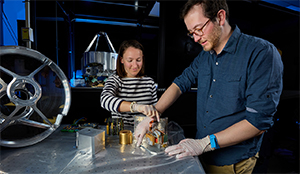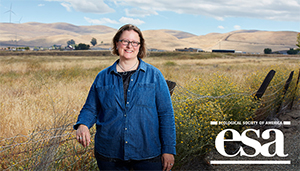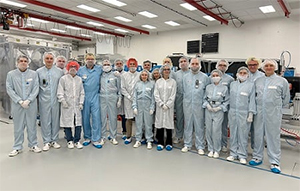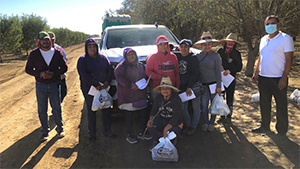LAB REPORT
Science and Technology Making Headlines
May 3, 2024


Lead mechanical engineer Hillary Johnson and lead electrical engineer Collin Averill adjust a heat strap on the infrared detector assembly from the James Webb Space Telescope next to a model of Pandora’s telescope. Photo by Garry McLoud/LLNL
Coming to an exoplanet near you
Lawrence Livermore National Laboratory’s Pandora SmallSat mission recently passed NASA’s critical design review: a major milestone for the mission to continue its journey toward launch. The Pandora SmallSat mission will study planets beyond our solar system, known as exoplanets, and their stars.
Astronomers know there are more planets than stars. But the quest to understand what these worlds beyond our solar system are like leaves many unanswered questions — including if any might be habitable.
Pandora will untangle signals from 20 stars and their 39 exoplanets to understand how changes in starlight affect measurements of these worlds’ atmospheres. Understanding these signals is key to interpreting which signals are from exoplanet atmospheres and which are from starspots, stellar phenomena that are similar to sunspots and can contaminate data.


Jennifer Pett-Ridge has been named a fellow of the Ecology Society of America.
She digs dirt
The Ecological Society of America has announced its 2024 fellows, including Lawrence Livermore’s Jennifer Pett-Ridge.
The society’s fellowship program recognizes the many ways in which its members contribute to ecological research, communication, education, management and policy. This year, the ESA governing board has confirmed nine new fellows and 10 new early-career fellows. Pett-Ridge was selected for her work in soil ecology.
As the child of a master gardener, Pett-Ridge acquired a taste for the outdoors from an early age and knew that she wanted to go into a field related to the environment, eventually growing to become an expert in soils.
Pett-Ridge has a track record of bringing together big teams and encouraging diverse team members’ ideas and talents. She also is passionate about training the next generation of young scientists and has played an increasing role in teaching and mentoring graduate students via her appointments at UC Merced and UC Berkeley.


International team of researchers from LLNL, Fraunhofer ILT and ELI at the ELI Beamlines Facility, Prague. Photo courtesy of ELI ERIC.
Machines help push the limits
Collaborating scientists from Lawrence Livermore National Laboratory (LLNL), Fraunhofer Institute for Laser Technology ILT (Fraunhofer ILT), and Extreme Light Infrastructure (ELI) are leading an effort to optimize high-intensity high-repetition-rate laser technology using machine learning. The collaboration, the researchers said, aims to increase understanding and practical application of high-intensity lasers.
“Our goal was to demonstrate robust diagnosis of laser-accelerated ions and electrons from solid targets at a high intensity and repetition rate,” said LLNL lead researcher Matthew Hill. “Supported by rapid feedback from a machine-learning optimization algorithm to the laser front end, it was possible to maximize the total ion yield of the system.”
More than 4,000 shots were fired during the campaign, which consistently exceeded laser intensities of 3 × 1021 W/cm² onto solid targets, demonstrating optimization of ion yield above the nominal baseline performance. The experiment took place at the ELI Beamlines Facility in Czechia, where the researchers used the state of the art High-Repetition-Rate Advanced Petawatt Laser System (L3-HAPLS) to generate protons in the laser-plasma ion accelerator.
According to the researchers, the effort supports future advancements in fields such as medical therapy, materials science and non-destructive analysis in areas such as cultural heritage and archaeology.


Firebaugh former mayor and current council member and Socio-Environmental and Education Network member Felipe Perez gives out information about COVID to fieldworkers in the community of West Fresno. Image courtesy of Minerva Uribe-Robles.
A leap forward to a clean-energy future
Lawrence Livermore National Laboratory (LLNL) will provide technical assistance to 30 disadvantaged communities in west Fresno County to provide a future in clean-energy projects, including carbon capture and storage.
The project is part of the Department of Energy’s Local Energy Action Program (LEAP) that aims to facilitate sustained community-wide economic and environmental benefits primarily through DOE's clean-energy deployment work. This opportunity is specifically open to low-income, energy-burdened communities that also are disadvantaged and/or are experiencing direct economic impacts from a shift away from historical reliance on fossil fuels. Under Communities LEAP, DOE matches selected communities with technical assistance providers who assist them with bringing their clean-energy planning and economic development vision to life.
The West Fresno County C-LEAP cohort 2 is part of 30 communities that were selected to have technical assistance from a national laboratory, in this case LLNL. Its focus will be clean-energy planning and development, carbon capture and storage. It is led by a non-profit from the Central Valley, the Socio-Environmental and Education Network (SEEN), which has worked with west Fresno County disadvantaged communities since 2016 on STEM education, environmental justice and climate resilience. It also involves the participation of community leaders and Firebaugh former mayor and current council member Felipe Perez and Mendota mayor Victor Martinez. (SEEN members are lead authors of California's 4th Assessment for the San Joaquin Valley Region).


A 2D MARBL simulation of the N210808 “Burning Plasma” shot performed at the National Ignition Facility at the onset of ignition. This calculation consists of 19 million high-order quadrature points and ran on El Capitan predecessor system rzAdams (on AMD MI300A GPUs). Animation by Rob Rieben.
Accelerating toward El Capitan
Researchers at Lawrence Livermore National Laboratory (LLNL) have achieved a milestone in accelerating and adding features to complex multi-physics simulations run on Graphics Processing Units (GPUs), a development that could advance high-performance computing and engineering.
As LLNL readies for El Capitan, the National Nuclear Security Administration’s first exascale supercomputer, the team’s efforts have centered around the development of MARBL, a next-generation multi-physics code, for GPUs. El Capitan is based on AMD’s cutting-edge MI300A Accelerated Processing Units (APUs), which combines Central Processing Units (CPUs) with GPUs and high-bandwidth memory into a single package, allowing for more efficient resource sharing.
El Capitan’s heterogeneous (CPU/GPU) computing architecture, along with expectations that most future supercomputers will be heterogeneous, made it imperative that multi-physics codes like MARBL — which targets mission-relevant high-energy-density (HED) physics like those involved in inertial confinement fusion (ICF) experiments and stockpile stewardship applications — could perform efficiently across a wide variety of architectures, researchers said.





